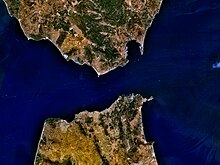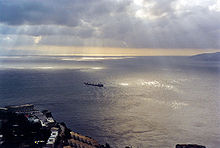Strait of Gibraltar crossing

A Strait of Gibraltar crossing is a hypothetical bridge or tunnel spanning the Strait of Gibraltar that would connect Europe to Africa.
The Spanish and Moroccan governments appointed a Joint Committee a to investigate the feasibility of linking the two continents. This resulted in the much broader Euromed Transport project 2003 - 2009.
Bridge
Several engineers have designs for a Gibraltar Bridge on various alignments and with differing structural configurations. Professor T.Y. Lin’s proposal for a crossing between Point Oliveros and Point Cires featured a 14-kilometre length, deep piers, and 5000-metre spans, far exceeding the longest current bridge span.[1]
In 2004 architect Eugene Tsui published his concept of a floating and submerged bridge connecting at a three mile wide floating island in the middle of the Mediterranean Sea.[2]
In 2004 The Science Museum included an image of the concept of the proposed Gibraltar Straits road bridge.[3][clarification needed]
Futurist author Arthur C. Clarke described a bridge across the Strait in his 1979 science fiction novel The Fountains of Paradise.
Tunnel
| Overview | |
|---|---|
| Location | Strait of Gibraltar |
| Status | Proposed |
| System | Railway tunnel |
| Operation | |
| Owner | Spanish and Moroccan governments |
| Technical | |
| Line length | 39 kilometres (24 mi) |
| Track gauge | 1,435 mm (4 ft 8+1⁄2 in) (standard gauge) |
| Lowest elevation | ~300 metres (980 ft) below sea level |
Various Gibraltar tunnels have been proposed.
A 2008 geological study cast doubt on its practicality. However in March 2009 a contract was issued for a joint system linking the Moroccan "Société Nationale d'Etudes du Détroit de Gibraltar" SNED with its Spanish counterpart, the "Sociedad española de estudios para la comunicacion fija a través del Estrecho de Gibraltar S.A" SECEGSA
The idea of a tunnel for petrol/diesel powered road vehicles has been discounted due to the currently very difficult engineering challenge of ventilation to remove exhaust gases from a tunnel some 14 kilometres (8.7 miles) long.[citation needed] A three-year study for a railway tunnel was announced in 2003. SNED and SECEGSA commissioned several sea-bed surveys.
The strait depth extends to 900 metres (3000 ft) at the shortest route, but only about 300 metres slightly further west, where the European and African plates meet. The shortest crossing is about 14 kilometres (8.7 miles), whereas the proposed route runs west of Tarifa and to the east of Tangier, is not straight, being some 23 km. The tunnel is likely to be about 34 km in all, and an additional rail line would be needed to link the Spanish end of the tunnel near Tarifa to Algeceras, where the current Talgo train-hotel service currently terminates.
The project would be financed by two publicly-owned companies, SECEGSA Spain and SNED in Morocco, with the assistance of the European Union. It is yet not clear if this will be a Euromed project or a commercial consortium.
A report [4][5][6] on the feasibility of the tunnel was presented to the EU in 2009 and a further study of the Project global assessment and evaluation is under development by a Group of specialized Consultants composed by Systra, Amberg and Cowi.
Planning
In December 2003, Spain and Morocco agreed[7][8] to explore the construction of an undersea rail tunnel to connect their rail systems. The tunnel would have linked Cape Malabata near Tangier with Punta Paloma 40 km west of Gibraltar.[9] In late 2006, Lombardi Engineering Ltd, a Swiss engineering and design company, was retained to draft a design for a railway tunnel.[10] According to the company, the main differences between the construction of this tunnel and that of the Channel Tunnel, linking France and Great Britain, are the depth of the sea and the geological conditions. The area under the Strait is less stable than that under the English Channel, as an active major geologic fault, the Azores-Gibraltar Transform Fault, bisects the Strait, and severe earthquakes have occurred in the area. The presence of two very deep Quaternary clay channels in the middle of the Strait also makes construction complex,[4] causing doubts about the feasibility of the project and proposals for an exploratory tunnel.[11]
It is projected to carry 9 million passengers in its first year of operation, expected to be 2025. No official figures about the cost of the project had been announced by 2007, but previous estimates were at least five billion Euros.[12]
Technical aspect

The proposed rail tunnel would be 40 kilometres (25 mi) long, 300 metres (980 ft) deep,[5] and its construction could take 15 years. An earlier plan was to link the two continents via the narrowest part of the strait, but this idea was dismissed as it is 900 metres (~3000 ft) deep. Even 300 m is deep since the deepest undersea tunnel, the Eiksund tunnel is 287 m (942 ft) below sea level.
Terminals might need to be constructed for trans-shipment of road vehicles, like those at Cheriton and Frethun.
See also
References
- ^ "Gibraltar Bridge - Feasibility Study". OPAC Consulting Engineers. 2003. Retrieved 2009-03-05.
- ^ "Strait of Gibraltar Floating Bridge". Tsui Design & Research, Inc. 2004. Retrieved 2009-03-05.
- ^ Suspension bridge technology
- ^ a b "Project of the fixed link through the strait of Gibraltar" (PDF). November 2007. Retrieved 3 February 2009.
{{cite web}}: Unknown parameter|works=ignored (help) - ^ a b Wood, Danny (2008-07-19). "Spain-Africa link decision 'near'". BBC News. Retrieved 2008-07-20.
- ^ "El proyecto del túnel del Estrecho llegará en 2009 a manos de la UE en busca de apoyos [[:Template:Es]]". 20 minuto.es. 16 November 2008. Retrieved 3 February 2009.
{{cite news}}: URL–wikilink conflict (help) - ^ "Europe-Africa rail tunnel agreed". BBC News. 14 December 2003. Retrieved 3 February 2009.
- ^ "Africa and Europe set for tunnel link". BBC News. 13 March 2007. Retrieved 3 February 2009.
- ^ "Spain and Morocco agree to rail tunnel under Gibraltar strait". wsws.org. Retrieved 2007-01-10.
- ^ swissinfo with agencies. "Swiss plan tunnel under Strait of Gibraltar". swissinfo.org. Retrieved 2007-01-10.
- ^ "Doubts cast over tunnel plan". Middle East Online. 29 September 2008. Retrieved 3 February.
{{cite news}}: Check date values in:|accessdate=(help) - ^ Tremlett, Giles (20 October 2006). "By train from Europe to Africa - undersea tunnel project takes a leap forward". London: The Guardian. Retrieved 2007-01-10.
External links
- The original Trans-Global Highway proposal. Frank Didik. 2006
- "Gibraltar: Tunnel under troubled waters". 30 June 2008. Retrieved 3 February 2009.
- A man from Ticino to link Europe and Africa
- "Website of the project of the fixed link through the Strait of Gibraltar". Archived from the original on 2007-05-16. Retrieved 3 February 2009.
